| Pages:
1
2 |
wg48
National Hazard
   
Posts: 821
Registered: 21-11-2015
Member Is Offline
Mood: No Mood
|
|
Ruby red manganese sulphate ???
I washed the black mixture from a used dry battery several times with water.
Then left some of the mixture to digested in dilute sulphuric acid (about 16%).
As the insoluble parts of the mixture settled out the solution had a distinct pink colour.
On standing the solution gradually darkened to a deep ruby red. It has an acid pH of about 2.
The only ruby red manganese salt I know of is the Mn(III) EDTA complex.
Can anyone suggest what is causing the ruby red color:
|
|
|
Neme
Hazard to Self
 
Posts: 86
Registered: 28-5-2016
Location: Czech republic
Member Is Offline
Mood: No Mood
|
|
Can you post pictures please?
|
|
|
DraconicAcid
International Hazard
    
Posts: 4278
Registered: 1-2-2013
Location: The tiniest college campus ever....
Member Is Offline
Mood: Semi-victorious.
|
|
Mn(III) salts are very dark red, but they aren't very stable.
Please remember: "Filtrate" is not a verb.
Write up your lab reports the way your instructor wants them, not the way your ex-instructor wants them.
|
|
|
wg48
National Hazard
   
Posts: 821
Registered: 21-11-2015
Member Is Offline
Mood: No Mood
|
|
Promted by your statement I searched again for the color Mn(III) and found this confirmation:
"The 3+ oxidation state is seen in compounds like manganese(III) acetate; these are very powerful oxidizing agents. Solid compounds of manganese(III)
are characterized by their preference for distorted octahedral coordination and their strong purple-red color."
Source: Boundless. “Manganese.” Boundless Chemistry. Boundless, 08 Aug. 2016. Retrieved 26 Oct. 2016 from https://www.boundless.com/chemistry/textbooks/boundless-chem...
I think your correct. The ruby red color is almost certainly Mn(III). Perhaps the pink Mn(II) on standing was oxidized by air to the ruby red
Mn(III), or perhaps by a Mn oxide.
Apparently Mn(III) forms in a few days its stable in acid solution over several days.
I will repeat the experiment in a test tube to see if the ruby color developes from the surface down.
Neme: I will take pics just for you. I did not the first time as I was not expecting anything unusual.
|
|
|
Neme
Hazard to Self
 
Posts: 86
Registered: 28-5-2016
Location: Czech republic
Member Is Offline
Mood: No Mood
|
|
I have manganese(II) acetate and manganese(II) sulphate which are both pink in solution. I have also manganese(II) chloride which is kinda
orangish-red in solution. It actually never happened to me to go dark red, lol.
|
|
|
DraconicAcid
International Hazard
    
Posts: 4278
Registered: 1-2-2013
Location: The tiniest college campus ever....
Member Is Offline
Mood: Semi-victorious.
|
|
Mn(II) will not be oxidized by air. You will only get Mn(III) in acidic solution if it's gradually reacting with MnO2 (which, I believe, was slowly
settling out of solution).
Please remember: "Filtrate" is not a verb.
Write up your lab reports the way your instructor wants them, not the way your ex-instructor wants them.
|
|
|
woelen
Super Administrator
        
Posts: 7976
Registered: 20-8-2005
Location: Netherlands
Member Is Offline
Mood: interested
|
|
Manganese(III) is not stable, certainly not in solution. I very easily hydrolyses to brown Mn2O3 (even at low pH) and it also is very easily oxidized
to manganese(IV). I made manganese(III) salts in solutions sometimes and my experience is that it is hard to keep around for prolonged time. With
malonic acid one can get quite stable solutions of manganese(III).
|
|
|
wg48
National Hazard
   
Posts: 821
Registered: 21-11-2015
Member Is Offline
Mood: No Mood
|
|
Here is a pic of the solution. It about two weeks old. The color on my display compared to the actual solution under my lighting is about correct. If
anything the actual solution is slightly more redish
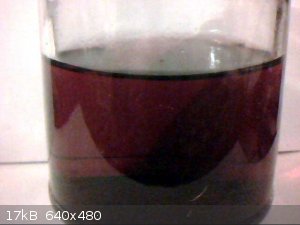
I took a few ml of the solution and added a few drops ethanol no observable reaction even with warming.
When I added about 0.5ml of saturated glucose solution, the red colour was destroyed in seconds. I could observe no pink coloration but this was in
10mm diameter test tube.
[Edited on 26-10-2016 by wg48]
|
|
|
wg48
National Hazard
   
Posts: 821
Registered: 21-11-2015
Member Is Offline
Mood: No Mood
|
|
Here is an interesting paper on the stablity of Mn(III)
https://www.google.co.uk/url?sa=t&rct=j&q=&esrc=...
from that paper:
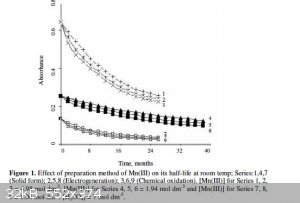
|
|
|
elementcollector1
International Hazard
    
Posts: 2684
Registered: 28-12-2011
Location: The Known Universe
Member Is Offline
Mood: Molten
|
|
Mn(II)'s color can be a bit hard to see unless it's concentrated or the solution is thick. What do you think the reaction products with glucose were?
Elements Collected:52/87
Latest Acquired: Cl
Next in Line: Nd
|
|
|
blogfast25
International Hazard
    
Posts: 10562
Registered: 3-2-2008
Location: Neverland
Member Is Offline
Mood: No Mood
|
|
Quote: Originally posted by wg48  | I washed the black mixture from a used dry battery several times with water.
Then left some of the mixture to digested in dilute sulphuric acid (about 16%).
As the insoluble parts of the mixture settled out the solution had a distinct pink colour.
On standing the solution gradually darkened to a deep ruby red. It has an acid pH of about 2.
The only ruby red manganese salt I know of is the Mn(III) EDTA complex.
Can anyone suggest what is causing the ruby red color:
|
I've used 50 % H2SO4 to dissolve MnO2 and it gives ruby red Mn(+3). 16 % H2SO4 seems low
though.
Bear in mind that dry battery gunge from spent batteries contains Mn in the +3 OS: that's how the battery delivers its
power: Mn(+4) to Mn(+3)/Zn(0) to Zn(+2).
I disagree somewhat with woelen on the stability of Mn(+3) solutions: mine proved fairly stable. Not so long ago I found a research paper
investigating the use of Mn(+3) solutions as oxidising titrant solutions.
[Edited on 27-10-2016 by blogfast25]
|
|
|
DraconicAcid
International Hazard
    
Posts: 4278
Registered: 1-2-2013
Location: The tiniest college campus ever....
Member Is Offline
Mood: Semi-victorious.
|
|
Quote: Originally posted by blogfast25  |
I disagree somewhat with woelen on the stability of Mn(+3) solutions: mine proved fairly stable. Not so long ago I found a research paper
investigating the use of Mn(+3) solutions as oxidising titrant solutions. |
Vogel's Quantitative Analysis has a section on it, so it can't be that unstable. 3rd Edition (1961), Section III 83-85.
Please remember: "Filtrate" is not a verb.
Write up your lab reports the way your instructor wants them, not the way your ex-instructor wants them.
|
|
|
blogfast25
International Hazard
    
Posts: 10562
Registered: 3-2-2008
Location: Neverland
Member Is Offline
Mood: No Mood
|
|
A bottle of approx. 1 M Mn3+ that I've kept for years still has colour. But there's also MnO2 precipitate.
And an Rb/Mn(+3) alum has also been reported.
|
|
|
wg48
National Hazard
   
Posts: 821
Registered: 21-11-2015
Member Is Offline
Mood: No Mood
|
|
Quote: Originally posted by elementcollector1  | | Mn(II)'s color can be a bit hard to see unless it's concentrated or the solution is thick. What do you think the reaction products with glucose were?
|
Yes I doubt I would be able to detect the Mn(II) pink color in a 10 mm test tube.
On the assumption the red color is Mn(III) I would expect the reaction products to be Mn(II) and various oxidation products of glucose.
I should also add that the black mixture fresh from a battery has a distinct but weak organic smell reminiscent of MEK/acrylic. That smell and the
stickiness of the mixture suggested to me it may contain an organic thickening agent.
PS: I found this; The oxidation of carbohydrates with trivalent manganese leads to formic acid and the next lower aldose, which in turn can react
with Mn(III). The final products are therefore formic acid and formaldehyde (Bhatnagar and Fadnis, 1978).
[Edited on 27-10-2016 by wg48]
|
|
|
woelen
Super Administrator
        
Posts: 7976
Registered: 20-8-2005
Location: Netherlands
Member Is Offline
Mood: interested
|
|
I consider manganese(III) unstable, because its solutions cannot be kept around without (partial) decomposition. Your posts confirm this to me (still
around, but with MnO2 precipitate).
There are some solid manganese(III) compounds which can be kept around, but these are rare. One example is the following: http://woelen.homescience.net/science/chem/compounds/mangane...
I still have this sample, and indeed it still is nice and purple. Solutions of this at very low pH, however, tend to decompose in days.
|
|
|
Metallus
Hazard to Others
  
Posts: 116
Registered: 16-5-2013
Member Is Offline
Mood: No Mood
|
|
I've already seen that color.
Back in university days I had this mania of preparing oxidising mixes and then forgetting them in the balcony. I had prepared a 0.1M solution of KMnO4
in 2M H2SO4 and stored it in a PET bottle. After a week standing in the balcony under the sun, it turned from purple to that dirty red.
|
|
|
woelen
Super Administrator
        
Posts: 7976
Registered: 20-8-2005
Location: Netherlands
Member Is Offline
Mood: interested
|
|
I also know that color of old permanganate solutions. I think, however, that in that case the color is due to formation of very finely suspended
hydrous MnO2, which, mixed with not yet decomposed permanganate ion, gives the red color. In the very long run I expect the liquid to become colorless
with a thin layer of dark brown precipitate at the bottom.
|
|
|
DraconicAcid
International Hazard
    
Posts: 4278
Registered: 1-2-2013
Location: The tiniest college campus ever....
Member Is Offline
Mood: Semi-victorious.
|
|
Very nice! Do you have a prep for this material?
Please remember: "Filtrate" is not a verb.
Write up your lab reports the way your instructor wants them, not the way your ex-instructor wants them.
|
|
|
woelen
Super Administrator
        
Posts: 7976
Registered: 20-8-2005
Location: Netherlands
Member Is Offline
Mood: interested
|
|
I purchased this sample, but I also made this material myself, but did not isolate it.
I added some MnSO4.H2O to 85% phosphoric acid. To this, I added a little amount of an oxidizer (KClO3 or KNO3 will do). Then I heated the mix until
all of the solids dissolve. The liquid then turns deep purple, a very bright color. This is due to oxidation of Mn(2+) to Mn(3+) and coordination of
this ion to the pyrophosphate ion, which is formed on strong heating of the phosphoric acid. I do not know, however, how this can be isolated from the
acid and other reagents.
A procedure for making this from MnCl2, phosphoric acid and ammonium carbonate (and oxygen from air as oxidizer) is described in the 1915 book "The
Chemistry of Paints and Painting" by Sir Arthur H. Church. You can find the full text here: https://archive.org/stream/chemistryofpaint00chur/chemistryo...
Maybe you can download it, but I did not try that. You can at least read it online.
|
|
|
DraconicAcid
International Hazard
    
Posts: 4278
Registered: 1-2-2013
Location: The tiniest college campus ever....
Member Is Offline
Mood: Semi-victorious.
|
|
Quote: Originally posted by woelen  | I purchased this sample, but I also made this material myself, but did not isolate it.
I added some MnSO4.H2O to 85% phosphoric acid. To this, I added a little amount of an oxidizer (KClO3 or KNO3 will do). Then I heated the mix until
all of the solids dissolve. The liquid then turns deep purple, a very bright color. This is due to oxidation of Mn(2+) to Mn(3+) and coordination of
this ion to the pyrophosphate ion, which is formed on strong heating of the phosphoric acid. I do not know, however, how this can be isolated from the
acid and other reagents.
A procedure for making this from MnCl2, phosphoric acid and ammonium carbonate (and oxygen from air as oxidizer) is described in the 1915 book "The
Chemistry of Paints and Painting" by Sir Arthur H. Church. You can find the full text here: https://archive.org/stream/chemistryofpaint00chur/chemistryo...
Maybe you can download it, but I did not try that. You can at least read it online. |
Thanks. On Reddit, someone by the name of OldLabRat calls this his favourite inorganic synthesis:
"From classroom work: last year I had some students prepare Manganese Violet and that was a pretty good reaction for a lot of reasons. They melted
together MnO2, which they knew as a peroxide decomposition catalyst as well as being really, really black in color, with ammonium monophosphate
NH4H2PO4 (which is a fun prep all by itself due to glassy gorgeous birefringent crystals) and phosphoric acid H3PO4. The mess bubbles and burbles
ominously as it drives off water along with godknowswhat, until eventually it goes from black to a very very dark purple. Dumping into boiling water,
filtering, and washing with water gives the Manganese Violet pigment ammonium manganese (III) pyrophosphate - NH4MnP2O7. Nontoxic and pretty!"
Please remember: "Filtrate" is not a verb.
Write up your lab reports the way your instructor wants them, not the way your ex-instructor wants them.
|
|
|
wg48
National Hazard
   
Posts: 821
Registered: 21-11-2015
Member Is Offline
Mood: No Mood
|
|
I was curious about the manganese violet too.
I tried making it with aqueous solution of the required ions at varous pHs in what I hoped would be a triple decomposition reaction but only got a
light brown percipitate and some light brown jelly.
I did find these general preparation instructions: (one is an edited cut from the prep posted by Dr.acid)
1 It is made by means of manganous chloride and phosphoric acid, solutions of these compounds being mixed together, evaporated to dryness, and then
the residual mass fused. The fused mass is broken up and boiled with a solution of ammonium carbonate. The turbid liquor is allowed to settle, and
then the clear portion is decanted or filtered off and evaporated to dryness, and the residue fused. By grinding the fused mass and boiling it with
water a fine precipitate of 'manganese violet' separates: it is removed by filtration and thoroughly washed and dried
2 It is prepared by heating a mixture of Mn2O3, diammonium phosphate and phosphoric acid
3 They melted together MnO2, ammonium monophosphate NH4H2PO4 and phosphoric acid H3PO4. The mess bubbles until eventually it goes from black to dark
purple. Dumping into boiling water, filtering, and washing with water gives the Manganese Violet pigment ammonium manganese (III) pyrophosphate -
NH4MnP2O7.
4 Manganese violet is obtained by reacting phosphoric acid, ammonium dihydrogen orthophosphate, and manganese dioxide at temperatures above 450 °F
Sorry I did not note the sources.
[Edited on 28-10-2016 by wg48]
|
|
|
DraconicAcid
International Hazard
    
Posts: 4278
Registered: 1-2-2013
Location: The tiniest college campus ever....
Member Is Offline
Mood: Semi-victorious.
|
|
That first one is what's given in woelen's link.
Please remember: "Filtrate" is not a verb.
Write up your lab reports the way your instructor wants them, not the way your ex-instructor wants them.
|
|
|
wg48
National Hazard
   
Posts: 821
Registered: 21-11-2015
Member Is Offline
Mood: No Mood
|
|
Yes.
The test tube on the right is the 3-week-old Mn sulphate.
The tt on the left is two days old.
I estimate they both where made with about 16% acid and battery gunk.
The pic is an attempt to use my pc screen as colorimeter.
To the eye the right one is much lighter, empirically confirming the disproportion of the Mn(III) to Mn(II) and Mn(IV) over time
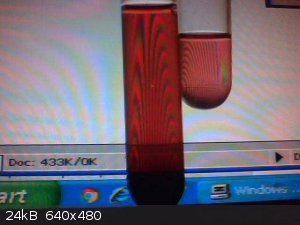
|
|
|
wg48
National Hazard
   
Posts: 821
Registered: 21-11-2015
Member Is Offline
Mood: No Mood
|
|
I tried again to produce the manganese violet. Using the ruby red solution of Mn to which I added diammonium phosphate (DAP) no observable reaction.
When I added tetra sodium pyrophosphate the colour changed to light purple (test tube on the right) but no precipitate formed. The test tube on the
left is the original ruby Mn.
Thinking about pyrophosphate is used in electro less nickel-plating to complex nickel. The colour change may be that effect and not manganese violet
though it may be the same mechanism in both.
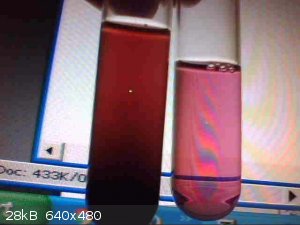
I then tried in a test tube melting some purified (ignited to remove the carbon) battery Mn oxide (0.5g) with DAP (2g) until no more vapour or ammonia
was given off. On cooling the mixture was dark almost black with a distinct purple colour.
Extraction with water produced a purple cloudy solution (most of the mixture remained in the test tube) which when filtered produced a purple
precipitate. Estimated yield 1%. I suspect phosphoric acid is in part required to dissolve the Mn violet.
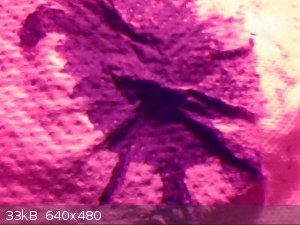
On standing with water most of dark mixture has now decomposed to produce a purple very cloudy solution.
[Edited on 31-10-2016 by wg48]
|
|
|
wg48
National Hazard
   
Posts: 821
Registered: 21-11-2015
Member Is Offline
Mood: No Mood
|
|
Just a quick up date.
I have very carefully washed my battery gunk with distilled water several times and lastly with 4% sulphuric acid to remove any zinc.
I tried to repeat the ruby red synthesis with the purified gunk but have not succeeded???
I still get a chlorine like smell particularly with 30% sulphuric on heating. I now think it may be sulphur dioxide??? I need some lead acetate.
Perhaps the gunk at the top of the filter is only carbon but I doubt that would reduce 30% acid. But then I get that smell with calcined gunk that
may have little to no carbon. It was heated in a microwave. That can heat the solution on the sides of the test tube much more than the bulk
solution.
Some references suggest the MnO2 is reduced to Mn(III)OOH in a used battery gunk which may dissolve more readily than an oxide.
Edit: I was impatient. Its difficult to see the ruby red colour in the presence of suspended gunk. Now the suspension in some of tests has settled
and the colour can be easily seen. There was a lot of fine carbon on the top of the filter cake.
The sample of the gunk that was calcined in air to remove the carbon then digested with 32% acid is particularly deep red considering the 10mm
diameter test tube. No spurious smells other than that of the acid. The heating was done with a flame so no super heating of the gunk on the test tube
walls that previously may account for the strong smell.
I can get on with making the Mn(II) sulphate now.
[Edited on 12-11-2016 by wg48]
|
|
|
| Pages:
1
2 |